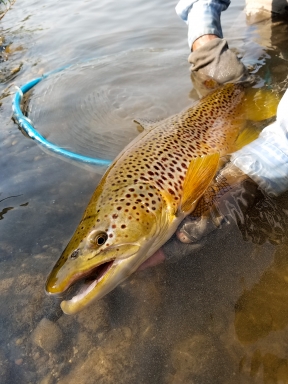
Back in the 1970s Dave Whitlock wrote an article in a fly fishing magazine entitled “Hoppertunity.” I don’t remember a lot about the article except that I was introduced to a new and very realistic and innovative pattern called Dave’s Hopper. Prior to this article the only hopper flies I had tried were not realistic and didn’t float well.
Not long after that I read Ernest Schwiebert’s “Grasshopper Wind” which was later published in his excellent book Remembrances of Rivers Past. Schwiebert’s ability to put me on the grassy banks of the Gunnison River with the wind blowing and giant trout smashing hoppers left me with great anticipation.
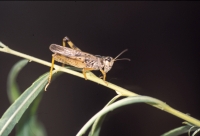
As a boy I frequently threaded a live hopper on a hook to cast with my fly rod but until I read the two essays on the subject I never focused on fishing artificial hopper imitations. It wasn’t until I was walking out of the Ranch when the wind came up brisk on a bright August day that I experienced my first grasshopper wind. Large trout prowled like sharks as I walked along the bank as dozens of grasshoppers floundered on the water when they failed to negotiate the hard wind.
I had limited success with my crude patterns with the trout of the Ranch. Just because the flies were big didn’t mean the trout were less selective. They spurned my offerings when the fly didn’t sit right in the water with a perfect drag-free drift. Eventually I realized that the popular patterns of the time would not cut it in the Ranch. For one thing, the body color on all of these hoppers was yellow. The natural hoppers in the ranch have a cream to white body. Using a model of a pontoon hopper first described by Vince Marinaro in his book, A Modern Dry Fly Code, I fashioned a realistic body of elk rump hair, an underwing of yellow deer hair, an overwing using pheasant rump feathers, and a bullet shaped head of natural gray elk hair. The new hopper didn’t incorporate any legs. Color wise, the new hopper was a dead ringer for the naturals. It also rested very low in the water, exactly like the naturals. The only problem was it was a little hard to see on the water but so were the naturals.
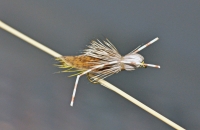
The new fly worked far better than I could have possibly imagined. By the time we established our business in 1976 I had made a few minor modifications using materials that were more readily available. The new fly needed a name and like a few other specialized flies we developed, we decided to name it after the river. We called it the Henry’s Fork Hopper.
With the advent of foam for fly tying, a plethora of hopper patterns have emerged. When tied right foam hoppers float right and realistic. A few of my favorite patterns include the Grand Hopper and the Morrish Hopper. Other foam body flies that are not exactly hopper patterns but fit the occasion nicely because of their high visibility include the Chubby Chernobyl. There is still a place for non-foam hoppers including Dave’s Hopper, Schroeder’s Parachute Hopper and the Henry’s Fork Hopper.
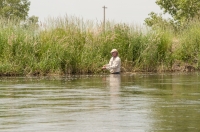
Where to fish is the utmost consideration for pattern selection. On quiet spring creek waters like the Ranch, Silver Creek, or the Upper Teton, a smaller realistic pattern that floats low in the film will usually out produce larger, bulkier hopper patterns. On fast water like the Madison larger patterns with high visibility will work best. Even so, on fast water I often use a tandem rig with a large pattern like a Grand Hopper or even a Chubby with a smaller Henry’s Fork Hopper tied off the bend of the hook as a 12” dropper.
One of the most popular ways to fish hoppers is to use a hopper/dropper rig with a nymph. One of the best patterns for this is Schroeder’s Parachute Hopper with a 2-Bit Hooker or Anato May Nymph as a dropper. The length of the drop is determined by the depth of the water. Don’t be afraid to change the length of the dropper as needed.
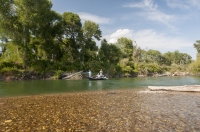
Last Saturday we floated with two boats from Lorenzo to Menan, a great hopper stretch of the South Fork. My wife Sheralee and I were in my boat while Shaun, our grandson Tanner and Shaun’s girlfriend Julie took his boat. Sherealee started with a size 8 pink Morrish Hopper. She rose several nice trout but couldn’t close the deal. Later I changed her to a parachute hopper with a nymph dropper. Most of the trout she hooked were on the hopper but her best fish took the nymph along a deep rubble strewn bank. We used a long dropper on the deep stretches and cut it down to about 2 feet in the riffles.
There are major disadvantages to using a nymph dropper. Often the best trout are tucked under a grassy bank or near other bank structure. It is impossible to get the fly to where the fish are with a dropper. Whenever Sheralee needed to get the fly close she cut the dropper off and replaced it again when we were in more suitable water.
I rowed most of the day and didn’t get a chance to fish until we pulled in to a long riffle near the lower end of the float. I shortened the nymph dropper. I hooked one nice brown on a nymph and both Sheralee and I landed a good brown on the dry.
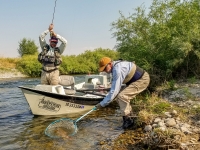
Earlier last week Charley Pettigrew invited me to join him on his guided trip with Curt Barker. We decided to float a section of the Lower Teton River. I fished clean up from the stern of the boat using a Morrish Hopper with an Anato May Nymph dropper. My best fish was an 18” brown on the dry. Charley didn’t use a dropper. He caught lots of nice fish but he set the hook a little quick when a monster brown took his fly slowly. We all had a good look at that trout that appeared to be at least 2 feet long. I’m sure Charley was still thinking about the big brown by the time we reached the take-out.
I’ve seen it happen before in the Louisiana marsh when literally on his last cast of the day Charley hooked and landed a 30+ lb bull redfish. Curt told Charley to make one last cast and then reel up because we were at the take-out. The next thing I saw was a huge bend in Charley’s rod and the line racing downstream. By the time we chased the fish down we were almost past the take-out. In the end Charley achieved redemption when Curt slipped the net under a magnificent 23 inch Brown Trout.
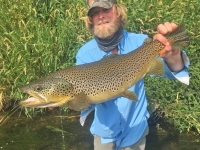
This past week Henry’s Fork Anglers’ guide Hootie Mauldin floated the lower Henry’s Fork below Ashton. They fished hoppers the entire day. While they didn’t get many fish, the ones they caught were very respectable. The best fish was a 25-1/2 inch brown.
There have also been some great trout caught on hoppers in the Ranch. Floating this section of the Henry’s Fork can be very productive because you can cover a lot of water. However, when floating you just get one pass. You’ll only be successful when you’re lucky enough to place your fly in a trout’s feeding lane.
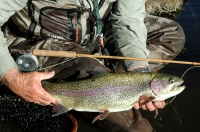
Wading provides a better opportunity to cover the water. The trout can be anywhere. If you don’t see fish rising you’ll need to make random casts wherever you feel trout could be holding. The better fishing is just off the banks that are perpendicular to the prevailing wind. There was a time when one could find relative solitude along these banks. Unfortunately, that isn’t true today. There are a few Ranch regulars who seem to feel they have established ownership of these areas. It isn’t unusual for someone to move right in on top of you when they feel you are fishing “their water.” You can also expect to get some angry scowls if you float past even if you give them a wide birth.
Not to worry. When the wind is up flying hoppers can sail far out into the water. Over the years I’ve caught lots of good fish in the middle of the river on the Ranch. Don’t be surprised when a trout takes your hopper even if it is rising so something much smaller. Once a trout has developed a taste for hoppers, it is hard to resist a well-placed imitation.
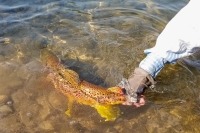
One reason I like Dave Whitlock’s term “Hoppertunity” is because I don’t know of another area of the country or the world for that matter that offers more opportunity to catch large trout with grasshopper patterns. The Madison, South Fork of the Snake, Teton, and Henry’s Fork not to mention the myriad of rivers and streams in Yellowstone Park, along with the many smaller tributaries and streams and even lakes all provide exceptional hopper fishing. It truly is an area and a time of Hoppertunity!